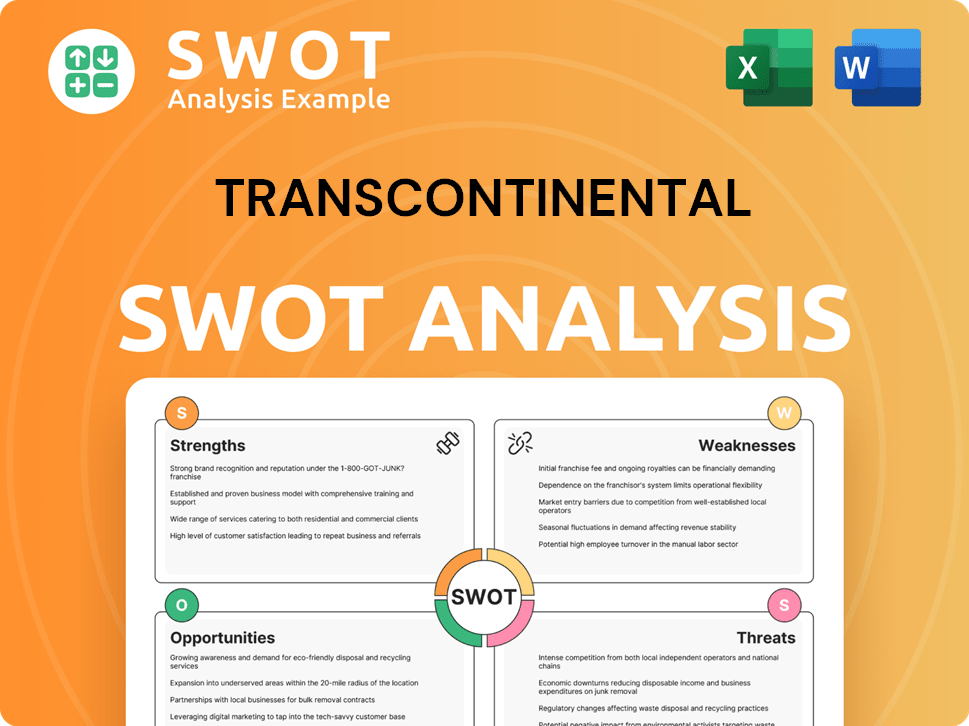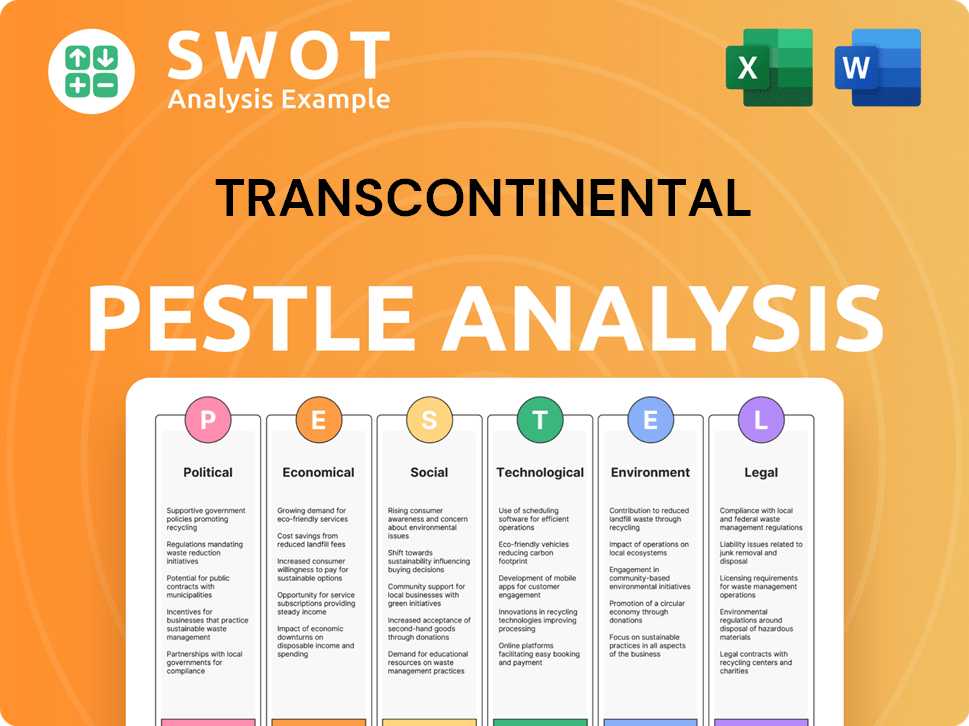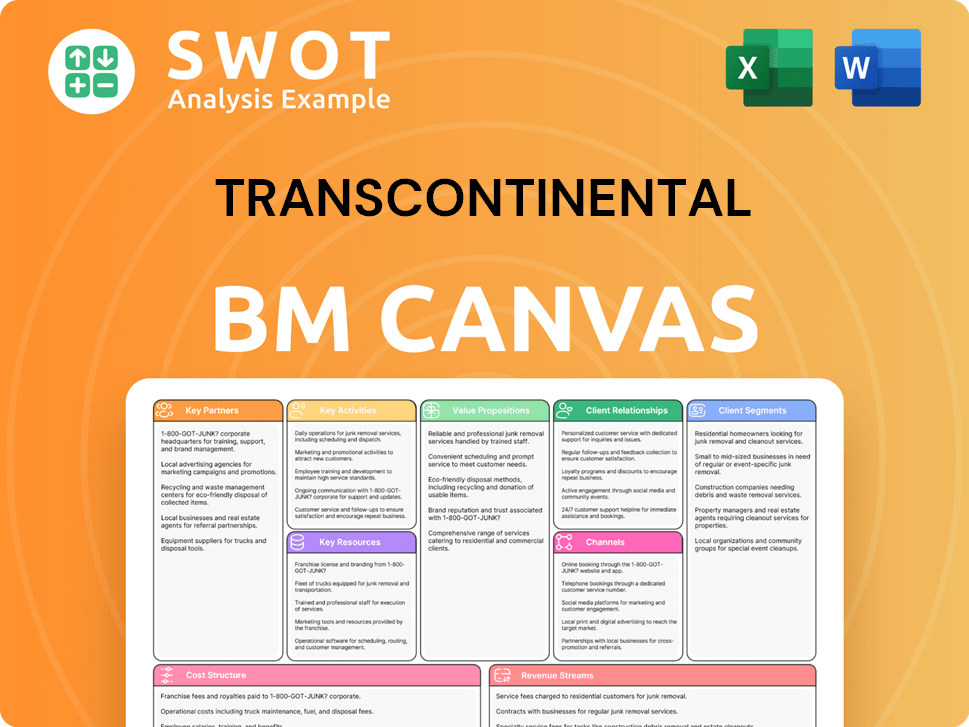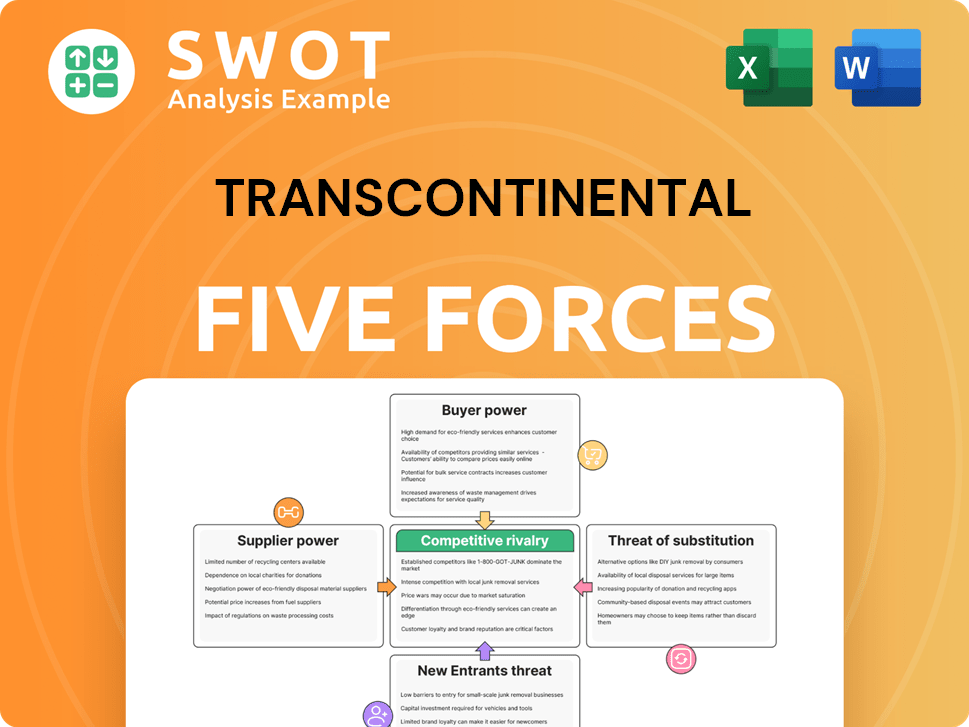Transcontinental Bundle
Who Does Transcontinental Company Really Serve?
Understanding customer demographics and target markets is crucial for any business, and Transcontinental Company is no exception. This analysis goes beyond surface-level observations, delving into the core of who Transcontinental's customers are and what drives their purchasing decisions. By examining the Transcontinental SWOT Analysis, we can see how this impacts their strategic choices.

The evolution of Transcontinental Company, from a print-focused entity to a diversified packaging and publishing powerhouse, highlights the dynamic nature of its customer base. This exploration of customer demographics and target market will provide insights into the company's strategic adaptations and how it caters to various consumer profiles. We'll uncover the demographic data of Transcontinental Company customers, their buying behavior, and the strategies used for market segmentation to understand its ideal customer profile and identify its target audience.
Who Are Transcontinental’s Main Customers?
Understanding the primary customer segments of the company is crucial for effective market segmentation and strategic planning. The company's diverse operations in flexible packaging, printing, and educational publishing mean it serves a wide range of clients. This article will delve into the key customer demographics and target market characteristics that define the company's business model.
The company's approach to its target market involves a mix of B2B and B2C strategies. Its packaging and printing divisions primarily cater to businesses, while its educational publishing arm focuses on institutions and consumers within the French-language educational sector. This dual approach allows the company to capture a broad customer base and adapt to market changes. Analyzing the customer demographics helps in refining strategies and maximizing market penetration.
The company's success hinges on its ability to understand and meet the needs of its diverse customer base. By focusing on customer demographics and conducting thorough audience analysis, the company can tailor its products and services to drive growth and maintain a competitive edge. The following sections will explore the specific segments and their characteristics in more detail.
The flexible packaging segment primarily serves businesses in the food and beverage, consumer products, and industrial sectors. These clients are typically large corporations seeking high-quality, innovative, and sustainable packaging solutions. Their decision-makers include procurement managers, brand managers, and R&D teams focused on efficiency and environmental impact.
In the printing segment, the company serves a broad range of B2B clients, including retailers, publishers, and marketing agencies. These customers require various printing services, from flyers and magazines to promotional materials. They generally prioritize speed, quality, and cost-efficiency. The company has adapted to evolving client needs by offering integrated marketing solutions.
The educational publishing group primarily targets schools, school boards, and educational institutions in French-speaking Canada (B2B). There's also a B2C component, where individual students or parents may purchase materials directly. This segment focuses on pedagogical quality, curriculum alignment, and digital integration. The company's approach to its target market involves a mix of B2B and B2C strategies.
The global flexible packaging market was valued at approximately $260 billion in 2024, with growth driven by demand for sustainable options. The company's strategic acquisitions and investments in this sector highlight its focus on higher-growth markets. The company's ability to adapt to market trends is crucial for maintaining its position. For more insights, see the Growth Strategy of Transcontinental.
Analyzing the customer demographics for each segment reveals distinct characteristics and preferences. Understanding these nuances allows the company to tailor its offerings effectively. This approach drives customer satisfaction and enhances market penetration.
- Flexible Packaging: Large corporations in the food and beverage, consumer products, and industrial sectors. Focus on sustainability and innovation.
- Printing: Retailers, publishers, and marketing agencies. Prioritize speed, quality, and cost-efficiency.
- Educational Publishing: Schools, school boards, and educational institutions in French-speaking Canada. Emphasis on pedagogical quality and digital integration.
- Market Segmentation: The company's diverse customer base requires a sophisticated approach to market segmentation.
Transcontinental SWOT Analysis
- Complete SWOT Breakdown
- Fully Customizable
- Editable in Excel & Word
- Professional Formatting
- Investor-Ready Format

What Do Transcontinental’s Customers Want?
Understanding the customer needs and preferences is crucial for the success of the Transcontinental Company. The company's approach is tailored to meet the diverse needs of its customers across different business segments. This involves a detailed analysis of market segmentation, audience analysis, and consumer profiles to ensure that products and services align with customer expectations and market trends.
The primary focus is on efficiency, innovation, and sustainability, which are key drivers for customer decisions. By addressing these factors, the company aims to strengthen its market position and foster long-term customer relationships. This customer-centric approach is essential for meeting the demands of a dynamic market and adapting to the evolving preferences of the target market.
The company's strategy involves gathering demographic data of Transcontinental Company customers and conducting market research to identify and understand their needs. This allows for the creation of tailored marketing messages and customized product features that resonate with each customer group. Analyzing customer buying behavior and identifying the target market for Transcontinental Company services are critical steps in this process.
In the flexible packaging sector, the primary focus is on sustainability. B2B customers are increasingly demanding eco-friendly solutions. This includes recyclable, compostable, and post-consumer recycled (PCR) content options. A 2024 industry report indicates that about 70% of brand owners actively seek more sustainable packaging materials. Purchasing behaviors are characterized by long sales cycles, technical specifications, and supply chain reliability. Decision-making often involves extensive testing and certifications.
- Sustainable Packaging: Customers prioritize eco-friendly options.
- Printing Segment: Speed to market, print quality, and cost-efficient production are key.
- Educational Publishing: Curriculum-aligned, engaging, and effective learning materials are preferred.
- Digital Integration: Blended learning solutions are gaining popularity.
Transcontinental PESTLE Analysis
- Covers All 6 PESTLE Categories
- No Research Needed – Save Hours of Work
- Built by Experts, Trusted by Consultants
- Instant Download, Ready to Use
- 100% Editable, Fully Customizable

Where does Transcontinental operate?
The geographical market presence of the company is primarily concentrated in North America, with a strong emphasis on Canada and the United States. This strategic focus is evident in its flexible packaging division, where it has established a leading position across various regions within these two countries. The company's operations are strategically located to serve key industrial and consumer product manufacturing hubs, ensuring high demand for its advanced packaging solutions.
The company leverages its extensive manufacturing footprint to maintain a strong market share and brand recognition within the North American flexible packaging markets. The company's focus on North America as its primary revenue generator underscores its concentrated market presence. This strategic approach allows the company to effectively serve its target market and adapt to regional differences.
The company's strategy includes continued investment in its North American flexible packaging plants to enhance capacity and introduce new sustainable product lines. The company has focused on organic growth and optimizing its existing operations within its established geographic strongholds rather than aggressive international expansion. Owners & Shareholders of Transcontinental will find this geographical strategy central to the company's overall financial performance.
Market segmentation involves dividing the broad consumer or business market into sub-groups of consumers (known as segments) based on shared characteristics. This allows the company to tailor its products, services, and marketing strategies to meet the specific needs of each segment. Effective market segmentation helps the company to allocate its resources more efficiently and improve its competitive advantage.
Customer demographics analysis involves gathering and examining data about a company's customer base, including age, income, education, and location. This data provides insights into the characteristics of the company's target market. Understanding these demographics helps in creating targeted marketing campaigns and developing products that meet customer needs.
Defining the target market involves identifying the specific group of people or businesses that the company aims to serve with its products or services. This includes understanding their needs, preferences, and behaviors. A well-defined target market enables the company to focus its marketing efforts and resources on the most promising customer segments, increasing the likelihood of success.
Audience analysis involves studying the characteristics, behaviors, and needs of the target audience to understand how to best reach and engage them. This analysis helps the company to tailor its messaging, marketing channels, and product offerings to resonate with the target market. Effective audience analysis improves the effectiveness of marketing campaigns and product development efforts.
Understanding customer buying behavior is crucial for the company to tailor its marketing strategies and product offerings effectively. This involves analyzing how customers make purchasing decisions, including their motivations, preferences, and the factors that influence their choices. Analyzing customer buying behavior helps the company to optimize its sales processes and improve customer satisfaction.
- The company's customer base is primarily concentrated in North America, with a strong presence in both Canada and the United States.
- The flexible packaging division serves key industrial and consumer product manufacturing hubs.
- The company focuses on organic growth and optimizing existing operations within its established geographic strongholds.
- The company adapts its sales and marketing strategies to resonate with local business cultures and regulations.
Transcontinental Business Model Canvas
- Complete 9-Block Business Model Canvas
- Effortlessly Communicate Your Business Strategy
- Investor-Ready BMC Format
- 100% Editable and Customizable
- Clear and Structured Layout

How Does Transcontinental Win & Keep Customers?
The company employs a comprehensive approach to customer acquisition and retention, focusing on both traditional and digital channels. For its B2B segments, particularly flexible packaging and printing, direct sales teams are crucial for acquiring new clients. Digital marketing, including targeted advertising and content marketing, is also used to generate leads and enhance brand awareness. The company leverages its reputation as a leading printer and packaging supplier to attract new business through referrals and industry credibility. Understanding the customer demographics and the target market is key to the success of these strategies.
Customer retention is a priority, especially in the B2B sector where long-term contracts are common. The company focuses on delivering high-quality products and services, ensuring reliable supply chains, and providing excellent after-sales support. This includes dedicated account management, technical support, and responsive customer service. Investing in advanced manufacturing and sustainable packaging solutions also helps retain clients. In 2024, the demand for sustainable packaging was a significant factor in client loyalty. This approach is vital for analyzing the Transcontinental Company target audience.
While specific details on loyalty programs or CRM systems aren't public, the company's emphasis on building strong relationships suggests a sophisticated approach to customer data and segmentation. Successful acquisition campaigns often highlight the company's innovation capabilities, such as new sustainable packaging formats, or its efficiency in large-scale print runs. Over time, the strategy has prioritized higher-value segments like flexible packaging, positively impacting customer lifetime value and churn rates by focusing on markets with stronger growth prospects and less cyclical demand. This approach helps in defining the customer demographics for the Transcontinental Company.
The direct sales force plays a crucial role in acquiring new clients, especially in the B2B flexible packaging and printing segments. They engage with potential clients through industry events, trade shows, and direct outreach. This face-to-face interaction allows for building relationships and understanding specific client needs. This strategy is essential for market segmentation.
Digital marketing channels, including targeted online advertising, content marketing (such as whitepapers and case studies), and a strong online presence, are used to generate leads and build brand awareness. This approach allows for reaching a wider audience and providing valuable information to potential customers. Understanding the customer buying behavior is key.
The company leverages its reputation as a leading printer and packaging supplier to attract new business through referrals and established industry credibility. This reflects the trust and quality associated with the company's brand. This is a key aspect of Transcontinental Company market research.
The company focuses on providing high-quality products and services to ensure customer satisfaction and retention. This includes reliable supply chains and excellent after-sales support. These factors contribute to building long-term relationships with clients. This is part of the Transcontinental Company customer segmentation strategies.
Investing in advanced manufacturing technologies and sustainable packaging solutions helps in retaining clients. Clients increasingly seek partners who can help them meet their sustainability goals, which is a growing trend in the industry. This is important for identifying the target market for Transcontinental Company services.
The company likely uses a sophisticated approach to customer data and segmentation to tailor offerings and communications. This allows for more effective targeting and personalized service. This helps in performing a detailed audience analysis.
Transcontinental Porter's Five Forces Analysis
- Covers All 5 Competitive Forces in Detail
- Structured for Consultants, Students, and Founders
- 100% Editable in Microsoft Word & Excel
- Instant Digital Download – Use Immediately
- Compatible with Mac & PC – Fully Unlocked

Related Blogs
- What are Mission Vision & Core Values of Transcontinental Company?
- What is Competitive Landscape of Transcontinental Company?
- What is Growth Strategy and Future Prospects of Transcontinental Company?
- How Does Transcontinental Company Work?
- What is Sales and Marketing Strategy of Transcontinental Company?
- What is Brief History of Transcontinental Company?
- Who Owns Transcontinental Company?
Disclaimer
All information, articles, and product details provided on this website are for general informational and educational purposes only. We do not claim any ownership over, nor do we intend to infringe upon, any trademarks, copyrights, logos, brand names, or other intellectual property mentioned or depicted on this site. Such intellectual property remains the property of its respective owners, and any references here are made solely for identification or informational purposes, without implying any affiliation, endorsement, or partnership.
We make no representations or warranties, express or implied, regarding the accuracy, completeness, or suitability of any content or products presented. Nothing on this website should be construed as legal, tax, investment, financial, medical, or other professional advice. In addition, no part of this site—including articles or product references—constitutes a solicitation, recommendation, endorsement, advertisement, or offer to buy or sell any securities, franchises, or other financial instruments, particularly in jurisdictions where such activity would be unlawful.
All content is of a general nature and may not address the specific circumstances of any individual or entity. It is not a substitute for professional advice or services. Any actions you take based on the information provided here are strictly at your own risk. You accept full responsibility for any decisions or outcomes arising from your use of this website and agree to release us from any liability in connection with your use of, or reliance upon, the content or products found herein.